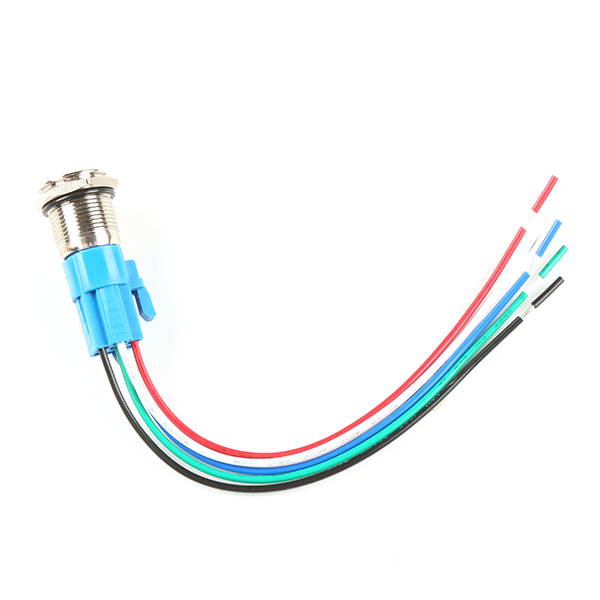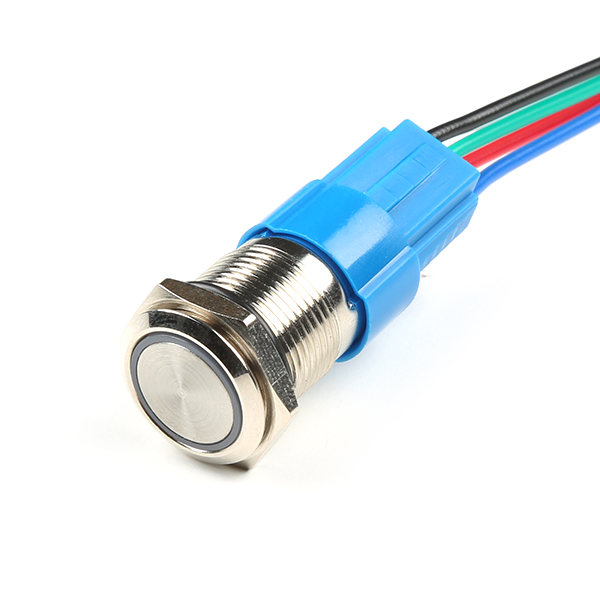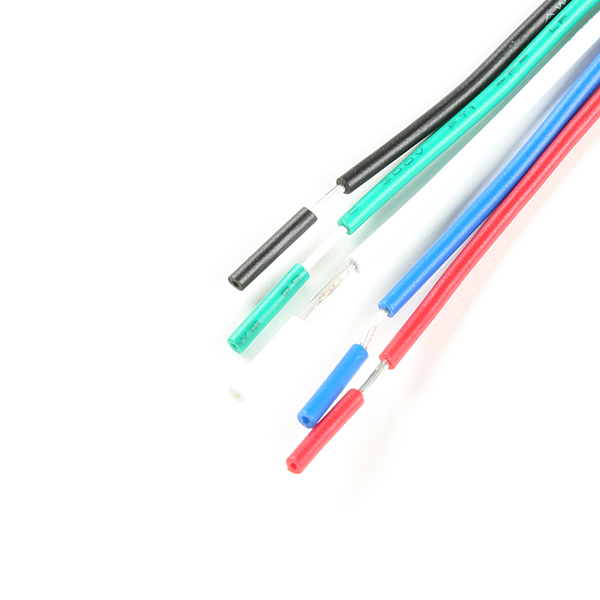Metal Pushbutton with Wires - Momentary (16mm, Green)
This is a perfect choice if you are in need of a heavy duty push button! These metal push buttons are a very tough, small, panel-mount momentary switch with an illuminated green LED ring. It is a SPDT with 16mm threading and 1mm pitch. This button is perfect for basic On/Off functions. Overall length (including leads) is 1.5" and has small solder lugs for connection. These momentary buttons are rated up to 3A and 250VAC while the LED is rated for 5-12V.
Note: The images for this button show an LED voltage rating of 5V. We have verified that the voltage range for the the LED to be 5-12V. We are currently communicating with our supplier for new documentation. Trust the branding on the button to verify your voltage requirement.
- Stainless Steel Body
- IP65 Weatherproof Rating
- Tamper Resistant
- Momentary Operation Type
- Green LED Ring
Metal Pushbutton with Wires - Momentary (16mm, Green) Product Help and Resources
Wireless Audio Bluetooth Adapter w/ BC127
December 14, 2017
Build a custom wireless audio Bluetooth adapter using BlueCreation's BC127 and add it to your old speaker system!
GPS Geo-Mapping at the Push of a Button
September 27, 2019
Let's ramp up our GPS tracking skills with KML files and Google Earth. We'll make a tracker that logs location and allows us to visualize our steps with Google Earth.
Pinout
The pushbuttons (like the momentary https://www.sparkfun.com/products/11966 or latching https://www.sparkfun.com/products/11971 ) have an indication of the pinout of the buttons on the side of the plastic molding. One way to test the switch is to use a multimeter turned to the continuity setting. Here are what the pins (not in any particular order associated with the pushbutton's spades):
+ = LED Anode
- = LED Cathode
C = "Common Ground"
NC = Normally Closed
NO = Normally Open
One way to light the LED on the metal push button would require you to wire it so that when you press down on the button, the led would light up. You would need 5V to light the LED ring. It can be lit up with a smaller voltage but the LED won't light up as bright.
To connect the battery to the button so that it only lights when the switch is pressed down (momentary or latched), you would connect 5V to the "+" pin on the switch. This is assuming that your system is using the same voltage source that is 5V. Then from the "+" pin, you would wire it to the normally open (NO) pin.
Another wire would be connected from the "-" pin to the C pin. The C pin would essentially be connected to your ground. So as you press down on the button, it would flip the switch and complete the circuit from the normally closed (NC) pin to normally open (NO) pin while lighting the LED ring at the same time. It might be a good idea to use a current limiting resistor (like standard 330Ohm resistor) if you are using 5V directly from your power supply. The LED won't be as bright but you also wouldn't be reducing the life of the LED. I am not sure of the electrical characteristics of the LED that is in the pushbutton.
Core Skill: DIY
Whether it's for assembling a kit, hacking an enclosure, or creating your own parts; the DIY skill is all about knowing how to use tools and the techniques associated with them.
Skill Level: Noob - Basic assembly is required. You may need to provide your own basic tools like a screwdriver, hammer or scissors. Power tools or custom parts are not required. Instructions will be included and easy to follow. Sewing may be required, but only with included patterns.
See all skill levels
Core Skill: Electrical Prototyping
If it requires power, you need to know how much, what all the pins do, and how to hook it up. You may need to reference datasheets, schematics, and know the ins and outs of electronics.
Skill Level: Competent - You will be required to reference a datasheet or schematic to know how to use a component. Your knowledge of a datasheet will only require basic features like power requirements, pinouts, or communications type. Also, you may need a power supply that?s greater than 12V or more than 1A worth of current.
See all skill levels
Comments
Looking for answers to technical questions?
We welcome your comments and suggestions below. However, if you are looking for solutions to technical questions please see our Technical Assistance page.
Customer Reviews
4.5 out of 5
Based on 8 ratings:
1 of 1 found this helpful:
Independent light and button; tactile click
This is a sweet looking button! The LED is electrically-separate from the button, so I can blink the light; light when the button is pushed; or leave the light on all the time, all under Arduino control.
I also like the nice positive tactile feedback of the button: push it in a little bit and you hear and feel a nice 'click' that lets you know the button is pressed.
The pinout is simple: "+" and "-" are the LED pins; "C1", "NO1" and "NC1" are the button Common, Normally-Open, and Normally-Closed connectors.
I also love the look and the mounting. It fits nicely with Art Deco or chrome themes.
1 of 1 found this helpful:
really high qaulity
Using this for a speedometer reset button in a hot rod. It's nice quality and I like how deep it is. Will be using these in the future for sure.
1 of 1 found this helpful:
Great Buttons
I have ordered over 20 of these buttons and they work very well. I have them tied into an Arduino Nano that controls an outdoor long range rifle targeting system. 10 of which have been in the field for 2 years and have not one has failed. The primary environmental exposure has been to the extreme Florida temperatures. I do have them protected under a clear cover so they have not been exposed to rain or debris.
Having the led not tied into the button opens up so many more possibilities and a resistor is not required.
Plan on buying many more.
Mike
0 of 1 found this helpful:
Good, so far
The product is fine, but your customer service is not so fine. Earlier this yesr, I wanted to order 39 of these switches. You only had 22 in stock. I talked to one of your people, trying to have you backorder the 17 switches, but no dice. Even though my overall order was for more than $600, I now have to reorder the additional 17 switches I need, with no quanity discount and also have to pay for shipping. It should of been very simple, and good business, for you to take my full order, shipped what you have and then wiat for the additional items. But you chose not to.
Hello!
Sorry about this experience with the service department. I reached out to the customer service manager and he said he would be happy to handle your case. You can reach them via email at cservice@sparkfun.com
Not bad
These metal pushbuttons are quite nice. They seem very durable and easy to work with. The picture is exactly what you get in the package. These are different than the 16mm pushbuttons that have the blue with 5 wire connectors, I'm not sure their actual name. I purchased some of them as well. These pushbuttons are a bit smaller than the ones with wires and hard for larger sized fingers. Overall these work for what I currently need. If I need more, I'd go with the ones with blue and 5 wires connector.
Slick product!!
Slick product glad i found them
They work!
Awesome button!
I bought this for the trigger button of an Arduino controlled catapult I'm building and it works great! The LED ring lights up brightly and looks nice. It's kind of small, but still easy to push. It makes a nice clicking noise when clicked.
I will definitely use more of these in my future projects.





Do these have some sort of regulator inside them to control the LED? I can't tell any difference in brightness when connecting to 5v or 12v regulated power. Does this mean they'll be ok to use in a 14v car installation?
"These buttons are rated up to 3A and 250VAC while the LED is rated for 5V." Can I use them with 5V Arduino even though they are 250VAC? Or do I have to specifically have to use DC rated buttons?
Finally! I have never been able to find a good source for these, even though I see them all over the place. THANK YOU!